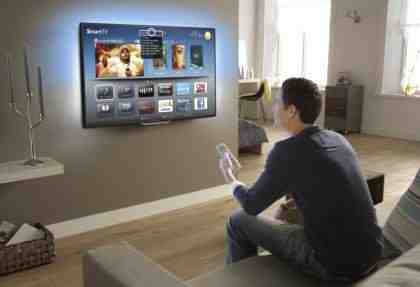Ever since an enterprising couch potato thought it would be a good idea to control a television from the sofa, rather than getting up to change the channel, TV remotes have pretty much stayed the same. Buttons are ideal for simple actions such as volume and power control, and the humble directional keypad makes short work of menus. However, the rise of Smart TV has changed all that.
Now that more and more TVs ship with web browsers, games and interactive applications, the humble remote control is beginning to show its limitations. There’s now more content available at your fingertips than you could possibly ever watch, but digging through menus or using virtual keyboards to search is slow and frustrating. Even something as simple as finding your favourite program on BBC iPlayer can involve going through four or five menu levels and entering text one letter at a time using a directional keypad.

TVs are becoming more like PCs, but the remotes are living in the past
It’s clearly time for a change, and each manufacturer has its own idea as to how best to do it, but so far no-one has really cracked it – at least not in our eyes. Novel new methods of interaction are rough around the edges and re-purposing ideas from other gadgets often misses the mark because they are unsuited to the sofa-based viewing experience.
THE PROBLEM
Samsung is particularly undecided, having taken something of a scattergun approach to its flagship ES8000 LCD TV this year. With two remote controls in the box, along with both voice and motion control, there was far too much choice for the average user, and it didn’t help that not one of these stood out as being really useful.
Its motion recognition boiled down to waving a hand and making a fist, which isn’t particularly suited to couch surfers, and the voice commands were basic, robotic statements that felt unnatural and were limited to specific actions. We imagine there was a lot of pressure internally to get the feature out, however well it actually worked; especially given the advertising possibilities it opened up.
We weren't aware Benny Hill had a second career as a Samsung engineer
In theory, voice and motion control are ideal ways to interact with technology, but not in their current forms. Currently, voice-controlled TVs have a pre-programmed list of commands that must be uttered exactly in order to register a match. If the company hasn’t programmed an alternative phrasing, you’re limited to a single statement to perform simple actions that takes a mere button press on a traditional remote control. The limited degree of recognition accuracy also means that unless you speak with a BBC-trained English accent, there’s a good chance your command won’t get recognised even if you get the wording correct.
We’re beginning to see more natural speech recognition programs in smartphones, particularly Apple’s Siri and Android’s Google Now. However these upload your speech to a server, which then parses that into text before searching for an answer and returning it. That's all well and good when you're looking for "A good Indian restaurant nearby", as you accept a greater delay in the response than when asking your TV for "BBC One".
Until you can accurately search for the title of a foreign film using a thick regional accent, the kind of voice control promised throughout science fiction feels like a long way away. After all the Enterprise never had any problems with Scotty's Scottish brogue.

Kinnect - motion control done right?
Effective motion control requires dedicated hardware and significant processing power, both things possessed by Xbox Kinnect but sorely lacking from all the TVs currently offering gesture recognition. Even at its best it is too dependent on sweeping arm-length gestures, which work best when stood up rather than crashed out on the sofa.
Over the page... the main offenders
